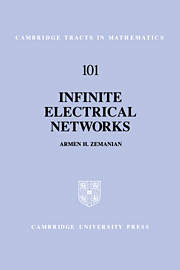4 - Finite-power Regimes: The Nonlinear Case
Published online by Cambridge University Press: 05 February 2012
Summary
The adjective “nonlinear” will be used inclusively by taking “linear” to be a special case of “nonlinear.” As promised, we present in this chapter two different theories for nonlinear infinite networks. The first one is due to Dolezal and is very general in scope – except that it is restricted to 0-networks. It is an infinite-dimensional extension of the fundamental theory for scalar, finite, linear networks [67], [115], [127]. In particular, it examines nonlinear operator networks, whose voltages and currents are members of a Hilbert space ℋ; in fact, infinite networks whose parameters can be nonlinear, multivalued mappings restricted perhaps to subsets of ℋ are encompassed. As a result, virtually all the different kinds of parameters encountered in circuit theory – resistors, inductors, capacitors, gyrators, transformers, diodes, transistors, and so forth – are allowed. However, there is a price to be paid for such generality: Its existence and uniqueness theorems are more conceptual than applicable, because their hypotheses may not be verifiable for particular infinite networks. (In the absence of coupling between branches, the theory is easy enough to apply; see Corollary 4.1-7 below.) Nonetheless, with regard to the kinds of parameters encompassed, this is the most powerful theory of infinite networks presently available. Dolezal has given a thorough exposition of it in his two books [40], [41]. However, since no book on infinite electrical networks would be complete without some coverage of Doleza's work, we shall present a simplified version of his theory.
- Type
- Chapter
- Information
- Infinite Electrical Networks , pp. 108 - 138Publisher: Cambridge University PressPrint publication year: 1991

